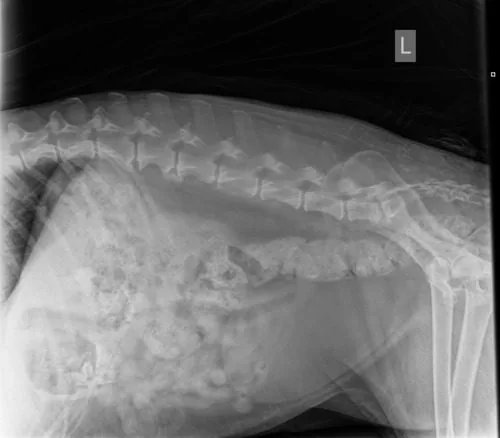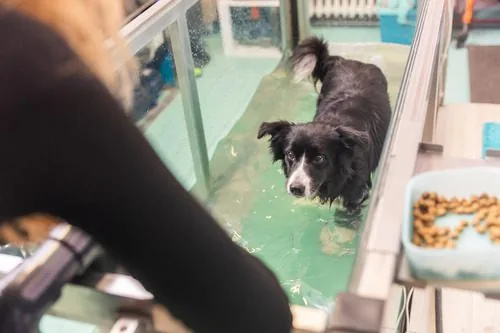Happy Tail Syndrome in Dogs: Causes & Treatment Options
Dogs show joy with their whole bodies, especially their tails. But for large breeds and high-energy dogs, this enthusiastic tail-wagging can sometimes cause injury. Happy tail syndrome in dogs is a frustrating and painful condition that occurs when a dog repeatedly injures the tip of their tail, often by wagging it against walls, kennels, or furniture. It’s a condition that sounds cheerful but can quickly turn into a recurring problem that affects a dog’s comfort and overall health. If your dog has a strong tail and a big personality, keep reading. This blog covers everything you need to know about happy tail syndrome, what causes it, and how Veterinary Healthcare Associates in Winter Haven, FL, can help. For questions or to schedule a visit, call us at (863) 324-3340.

What Is Happy Tail Syndrome in Dogs?
Happy tail syndrome in dogs refers to repeated injury to the tip of the tail due to excessive wagging. When a dog’s tail hits hard surfaces with enough force, the skin can break open, bleed, or develop ulcers. While it may start with a minor scrape, the injury often worsens over time due to continued wagging and the tail’s constant movement. This condition is most common in large dogs with long, muscular tails and an enthusiastic nature. It’s often seen in breeds such as:
- Labrador Retrievers
- Great Danes
- Greyhounds
- Pit Bulls
- Dobermans
Happy tail injuries can become chronic. Once the skin is damaged, it takes time to heal and healing is made more difficult by the tail’s continuous motion. This cycle of injury and re-injury can be hard to break without professional veterinary support.
What Causes Happy Tail Syndrome?
Happy tail syndrome in dogs typically stems from repetitive trauma. When a dog is happy or excited, their tail wags rapidly and forcefully, often hitting nearby surfaces. Over time, this repeated contact with hard objects causes skin abrasions, lacerations, or bruising at the tip of the tail.
Environmental Triggers
Dogs with limited space to move or those who spend time in kennels, crates, or tight hallways are more prone to this condition. Their tails often hit walls, cage bars, or doors when they wag, leading to injury. Even enthusiastic greetings at the front door can turn risky if the tail smacks against furniture or sharp corners.
Behavioral Triggers
High-energy dogs and those with excitable personalities are more likely to wag their tails aggressively. Dogs who frequently jump to greet people or who react strongly to guests, car rides, or walks are also at higher risk. In some cases, separation anxiety can result in frantic tail wagging when the owner returns home.
Symptoms of Happy Tail Syndrome in Dogs
It’s important to recognize the signs of happy tail syndrome early, as prompt treatment helps prevent long-term complications. Common symptoms include:
- Open sores or lacerations at the tip of the tail
- Blood splatters on walls, floors, or furniture
- Swelling, redness, or irritation near the tail end
- Persistent licking or chewing at the tail
- Signs of pain when the tail is touched
You might notice bloodstains around the house without realizing where they’re coming from. Dogs often wag through the pain, making it easy to miss the early stages of the injury. That’s why regular observation and quick response are important if you notice any of these signs.
Why Happy Tail Syndrome in Dogs Is Hard to Treat
The tail is a difficult area to keep clean and immobile. Because it’s constantly moving, especially when a dog is happy, even well-bandaged wounds can reopen. The tip of the tail also has poor blood circulation compared to other areas, which can slow the healing process.
Common Treatment Challenges
- Bandages fall off easily or get soiled
- Tail-tip injuries reopen due to motion
- Dogs may chew or lick at the bandaged area
- Bleeding may recur frequently
It’s not uncommon for a tail injury to appear healed, only to reopen a few days later after a bout of excitement. Repeated trauma not only extends healing time but also increases the risk of infection or deeper tissue damage.
Veterinary Care for Happy Tail Syndrome in Dogs
At Veterinary Healthcare Associates in Winter Haven, FL, we take happy tail syndrome in dogs seriously. Treatment depends on the severity of the injury and how long it has been recurring.
Initial Wound Care
The first step involves thoroughly cleaning the wound and stopping any active bleeding. Your veterinarian may apply a pressure bandage and recommend methods to limit tail movement. In some cases, a temporary protective sleeve or tail wrap may be used to help prevent further injury while allowing the area to heal.
Managing Pain and Inflammation
If the injury is causing pain or swelling, medication may be prescribed to help reduce inflammation and make your dog more comfortable during recovery.
Addressing Underlying Causes
In some cases, dogs may benefit from lifestyle changes to reduce tail trauma. Your veterinarian may suggest:
- Modifying the home environment
- Providing enrichment to limit overexcitement
- Reducing crate time or using padded barriers
For dogs prone to re-injury, these adjustments can be just as important as the treatment itself.
When Surgery Becomes an Option
If the tail fails to heal or the injury becomes chronic, your veterinarian may recommend partial tail amputation. This is typically considered only after less invasive treatments have not worked or if the wound poses a persistent risk of infection.
Tail Amputation: What to Expect
- It involves removing a portion of the tail to eliminate the area prone to injury
- Dogs generally recover well and adapt quickly after surgery
- Shortened tails often prevent future trauma
While it’s a last resort, tail amputation can provide a long-term solution for dogs with recurring and painful tail injuries. Our veterinary team will walk you through the process, including post-operative care and what to expect during recovery.
Tips for Managing Happy Tail Syndrome at Home
Although happy tail syndrome in dogs requires veterinary care, there are steps you can take at home to support your dog’s recovery and reduce the risk of re-injury.
Create a Safe Environment
- Use soft barriers around crates and tight hallways
- Remove sharp-edged furniture where the tail might hit
- Add padding to areas your dog frequents
Reduce Overexcitement
- Offer calming routines
- Use positive reinforcement to reward calm behavior
- Avoid overstimulating greetings or sudden excitement triggers
Monitor and Report Changes
Keep an eye on the tail and check it daily. If you see signs of redness, swelling, or bleeding, contact your veterinarian. Addressing the issue early can prevent it from becoming more serious.
Support for Long-Tailed, High-Spirited Dogs in Winter Haven
Happy tail syndrome in dogs may sound harmless, but for affected pets, it can become a persistent and painful issue. Whether your dog is showing early signs or you’ve been dealing with repeated injuries, Veterinary Healthcare Associates is here to help. Our team understands how frustrating this condition can be and will work with you to develop the best care plan for your dog. Call us at (863) 324-3340 to schedule an exam and get expert support tailored to your pet’s needs.
Recent Posts
When is Dog Diarrhea an Emergency?
When is Dog Diarrhea an Emergency? Dog owners know all too well that occasional digestive upset isn’t…
Is Cat Constipation an Emergency?
Is Cat Constipation an Emergency? Cats are often private about their habits, especially when it comes to…
Feline Emergencies: Warning Signs Your Cat is Crying for Help
Feline Emergencies: Warning Signs Your Cat is Crying for Help Cats have a reputation for being independent,…
Spondylosis in Dogs: Symptoms, Treatment, & More
Spondylosis in Dogs: Symptoms, Treatment, & More If your dog is slowing down or showing signs of…
Dog Wobbler Syndrome: Symptoms, Diagnosis, & Treatment
Dog Wobbler Syndrome: Symptoms, Diagnosis, & Treatment Wobbly walking, a stiff neck, or an unsteady gait in…
About Veterinary Healthcare Associates
Veterinary Healthcare Associates in Winter Haven, FL, was established over 30 years ago as Maxwell Animal Clinic by Dr. John Maxwell. Maxwell Animal Clinic was a one-doctor general practice offering preventive care, dentistry, and standard surgical services to the community. As the years passed, Maxwell Animal Clinic evolved into a thriving 10-doctor general, specialty referral, and emergency veterinary practice.








